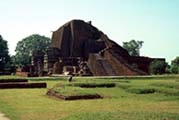The Rediff Special/B G Verghese
Bihar is weighed down by feudalism, casteism, violence, corruption, squalor, poverty, illiteracy, social oppression, stagnation and, above all, lack of political will
 Bihar is India's second largest state with a rapidly growing population that now numbers over 90 million. It is, sadly, about the most
backward state in the country despite splendid natural endowments.
It has fertile land, an abundance of water, minerals, forests
and, not least, a wealth of human resources. But it is weighed
down by feudalism, casteism, violence, corruption, squalor, poverty,
illiteracy, social oppression, stagnation and, above all, lack
of political will. It is not that absolutely nothing has happened;
and there have been some stirrings of late. But not enough. The
appalling fact of being one of the very poorest and most depressed
regions in the entire world marks Bihar with a brand of shame.
Bihar is India's second largest state with a rapidly growing population that now numbers over 90 million. It is, sadly, about the most
backward state in the country despite splendid natural endowments.
It has fertile land, an abundance of water, minerals, forests
and, not least, a wealth of human resources. But it is weighed
down by feudalism, casteism, violence, corruption, squalor, poverty,
illiteracy, social oppression, stagnation and, above all, lack
of political will. It is not that absolutely nothing has happened;
and there have been some stirrings of late. But not enough. The
appalling fact of being one of the very poorest and most depressed
regions in the entire world marks Bihar with a brand of shame.
This is more so as Bihar occupied pride of place in the golden
age of Indian history. The message of Mahavir, Gautama Buddha
and Ashoka are treasures of mankind. The Mauryan and Gupta empires
were renowned. Kautilya and his Arthashastra evoke images
of statecraft; Pataliputra of urban sophistication; Nalanda and
Rajgir of learning and enlightenment; Vaishali of early republicanism;
Aryabhatta and Varahamihira of science. What an inspiring record!
In more recent times, Bihar was in the forefront of the freedom
struggle. The Congress became a mass movement in 1917 under Gandhiji's
leadership of the Champaran struggle against British indigo planters.
The best and brightest flocked to Bihar. Given its rich coal and
iron deposits, it was understandably an early industrialiser symbolised
by Jamshedpur and Sindri. The state's administration was one of
the best and its legal, medical and educational institutions enjoyed
deservedly high reputations. Right until the 1960s its political
leadership and administrative cadres were held in high esteem.
Then followed a progressive decline.
Today Bihar is at rock bottom. With three other large Hindi-speaking
States -- UP, Madhya Pradesh and Rajasthan -- it is derisively labelled:
bimaru, sick. Many people are leaving the state for greener pastures.
A human development ranking of Indian states for 1993, compiled
on the UNDP model and based on a combined index of life expectancy,
educational attainments and state domestic product per capita,
places Bihar at the bottom with a score of 34 out of 100 as against
62 for Kerala and the Indian average of 42.
Its per capita SDP was Rs 3,084 in 1993 as against the Indian
average of Rs 6,255, again placing it last. Bihar's sex ratio (or
the number of females per 1,000 males) has been declining in recent
decades and stands at 911. Only UP is lower. These figures have
something to say about poverty and deprivation generally. More
particularly they speak of the depressed status of women and gender
inequality which are prime reasons for its high fertility and
population growth.
 As the country's least urbanised state, 87 per cent of the population
lives on the land. Yet, with a net cropped area double that of
Punjab, Bihar produces just half of Punjab's grain output. The population
has been growing faster than food production. The land-man ratio
has been falling sharply, compelling tens of thousands to migrate
to other states in search of work.
As the country's least urbanised state, 87 per cent of the population
lives on the land. Yet, with a net cropped area double that of
Punjab, Bihar produces just half of Punjab's grain output. The population
has been growing faster than food production. The land-man ratio
has been falling sharply, compelling tens of thousands to migrate
to other states in search of work.
Aggravating the educational backwardness of the state is its poor
nutritional status and health performance. Epidemics such as kala
azar (caused by the sandfly which breeds in dung) have returned
in epidemic form.
Mr Verghese's comments form part of the Kedar Nath Singh Memorial
Lecture which he delivered in Chhapra, Bihar, recently.
Tell us what you think of this article
|



